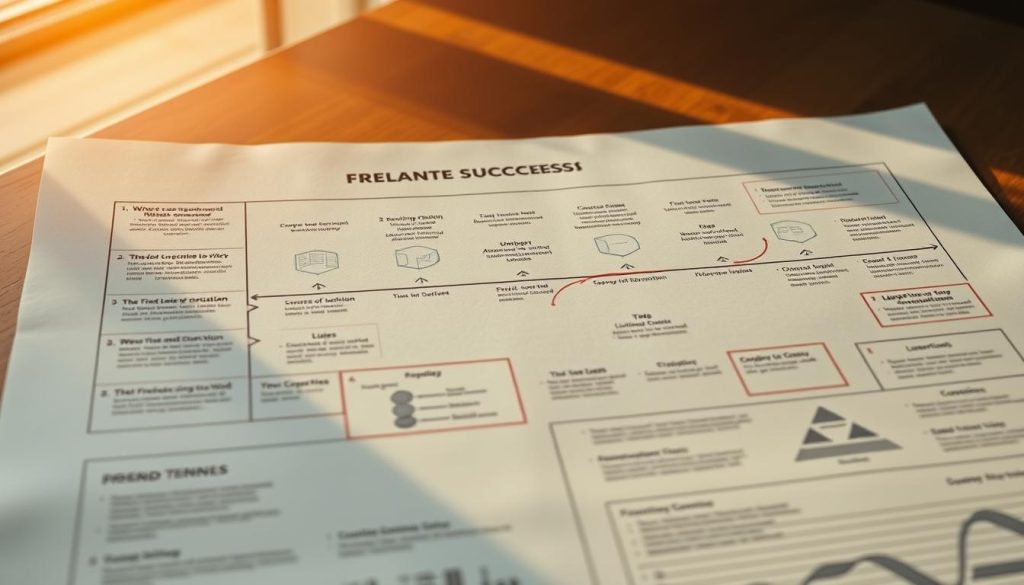Imagine sitting at a cluttered desk in a small London studio on a chilly November morning. The date was November 2, 2015—the first day of a journey that would transform a hesitant writer into a thriving independent professional. Five years later, that same individual managed a steady stream of clients, earning more than traditional roles ever offered. This story isn’t unique. It’s proof that building a fulfilling career on your terms is possible.
Starting an independent career can feel isolating. The uncertainty of finding consistent work, negotiating fair rates, and balancing multiple projects often overwhelms even the most talented professionals. But what if you had a clear roadmap? One that blends practical strategies with the mindset shifts needed to thrive?
We’ve crafted this guide to address those challenges head-on. Through real-world insights and actionable methods, you’ll learn how to turn skills into a sustainable business. Discover how to attract ideal clients, create systems for stability, and avoid common pitfalls that derail progress.
Table of Contents
Key Takeaways
- A strategic blend of skills and mindset is critical for long-term growth.
- Consistent client relationships form the backbone of a stable independent career.
- Practical systems help manage workloads and reduce burnout risks.
- Financial independence grows from balancing competitive rates with value delivery.
- Community support accelerates problem-solving and professional development.
Whether you’re transitioning from a traditional job or scaling your existing practice, this resource offers tools tailored to your goals. Let’s build a career that works for you—not the other way around.
Understanding the Evolving Freelance Landscape
The way people work has changed more in the last decade than in the previous fifty years. Independent professionals now operate in a world where 47% of young workers prefer flexible arrangements over traditional office jobs. This shift reflects deeper changes in how businesses value expertise and adaptability.
From Side Hustles to Strategic Careers
Early independent workers often faced skepticism. « People used to ask when I’d get a real job, » recalls a veteran designer with 12 years’ experience. Today, that narrative has flipped. Specialized professionals command rates matching corporate salaries while choosing projects that align with their skills.
Technology’s Transformative Role
Three key developments reshaped the industry:
- Global payment platforms enabling cross-border collaboration
- Cloud-based tools allowing real-time project management
- AI assistants streamlining administrative tasks
These innovations let skilled individuals focus on high-value work rather than logistical hurdles. A 2023 study showed 68% of full-time independent professionals maintain long-term client relationships, proving stability is achievable.
For those building a sustainable independent business, understanding these shifts is crucial. The market now rewards specialists who deliver measurable results, not just temporary fixers. As one tech consultant notes: « My clients don’t care where I work—they care that I solve their $50,000 problems. »
This new reality offers unprecedented freedom. But it demands strategic planning. Those who adapt thrive; others risk being left behind.
Overcoming Challenges and Embracing Opportunities
Building an independent career often feels like navigating uncharted waters. Waves of uncertainty test your resolve, but hidden beneath them lie currents of growth. The key lies in transforming obstacles into stepping stones.
Lessons Learned from Early Struggles
One professional’s journey began with sending 100 cold emails weekly. Only 1-2% received replies. But one response led to a £10,000 project. This pattern repeats across industries: consistent effort builds momentum.
| Outreach Strategy | Weekly Effort | Response Rate | Potential Return |
|---|---|---|---|
| Cold Emails | 100 sends | 1-2% | High-value contracts |
| Social Engagement | 15 interactions | 5% | Mid-size projects |
| Referral Requests | 10 asks | 20% | Steady work |
Delayed responses and rejections aren’t failures—they’re data points. Analyze patterns. Adjust your approach. One developer shared: “Tracking replies helped me refine my pitch. My conversion rate tripled in 6 months.”
Staying Motivated Through Persistence
Progress rarely follows a straight line. Celebrate small wins: a positive reply, a completed proposal. These milestones fuel determination during slow periods.
Set weekly targets for outreach and skill development. Pair them with rewards—a favorite coffee blend or an afternoon walk. This creates positive reinforcement loops. As one writer noted: “Marking completed tasks on my calendar kept me accountable.”
Remember, every “no” brings you closer to a “yes.” The right clients value expertise over convenience. Stay focused on long-term relationships rather than instant results.
Strategies for Achieving Freelance Success

Charting your course in the independent professional world requires more than talent—it demands a tailored roadmap. Professionals who thrive combine structured planning with adaptable execution. This approach transforms sporadic wins into predictable outcomes.
Building a Personalized Success Plan
Your unique skills and market position deserve a customized strategy. Start by defining three core elements: your specialty areas, ideal client profiles, and financial targets. A business coach specializing in independent careers notes: « The most effective plans balance ambition with achievable weekly actions. »
Consider these components for your framework:
- Quarterly objectives broken into monthly milestones
- Marketing activities aligned with your target audience’s needs
- Skill development timelines matching industry trends
Measuring Your Growth and Progress
Tracking the right metrics prevents stagnation. While revenue matters, client retention rates and project satisfaction scores often reveal deeper insights. One graphic designer increased repeat business by 40% after monitoring client feedback quarterly.
Essential indicators include:
- Conversion rates for proposals and pitches
- Time invested versus income generated per engagement
- Skill expansion through certifications or new service offerings
Regular reviews help identify what’s working. Adjust your methods using concrete data rather than assumptions. For those beginning their path to freelance success, monthly check-ins create momentum while preventing overwhelm.
Remember: Sustainable growth comes from balancing structure with flexibility. Refine your approach as you gain experience, keeping client value at the core of every decision.
Developing a Fearless Freelancer Mindset
Thriving professionals share one crucial trait: mental flexibility that turns obstacles into stepping stones. Your approach to challenges often determines career longevity more than technical expertise. Let’s explore how psychological tools transform temporary setbacks into growth opportunities.
Growth Mindset Versus Fixed Mindset
Consider two designers facing client rejections. One thinks: “I’ll never improve.” The other asks: “What can I learn here?” This contrast defines mindset differences. Research shows people with growth-oriented thinking achieve 37% better long-term results in dynamic fields.
| Growth Mindset | Fixed Mindset |
|---|---|
| Views skills as developable | Sees abilities as static |
| Embraces feedback | Avoids criticism |
| Persists through challenges | Surrenders to obstacles |
A seasoned developer shares: “When I stopped fearing mistakes, my project acceptance rate doubled.” This shift enables continuous improvement—the lifeblood of sustainable careers.
Building Grit and Resilience
Grit isn’t about never failing. It’s about restarting after setbacks. Try these evidence-based methods:
- Reframe rejections as data points for improvement
- Celebrate small daily progress markers
- Schedule weekly resilience-building exercises
One writer increased her client retention by 60% after adopting stress-management techniques. “Breathing exercises before negotiations changed everything,” she notes. Your capacity to adapt determines how work evolves over time.
« Resilience isn’t innate—it’s built through consistent practice like any professional skill. »
Remember: Mindset development requires daily attention. Pair strategic actions with self-compassion. Over time, this combination creates unshakable confidence in navigating professional uncertainties.
Diversifying Your Client Base for Long-Term Stability

A marketing specialist once lost half her income overnight when a key client shifted strategies. This harsh lesson underscores a critical truth: relying too heavily on one partnership jeopardizes your entire business. Diversification isn’t just wise—it’s essential for survival.
Client concentration creates invisible risks. When 50% of your work comes from one source, they dictate terms. You might accept lower rates or unreasonable deadlines to keep them. One developer shared: “I tolerated late payments for months, fearing to lose my main income stream.”
Managing Client Dependency Effectively
Implement the 38% rule—no single client should exceed this revenue threshold. This balance protects your money flow while maintaining valuable partnerships. Use this framework to assess your risk:
| Client Allocation | Risk Level | Growth Potential |
|---|---|---|
| 50%+ | Critical | Stagnant |
| 38% | Managed | Balanced |
| 25% | Optimal | High |
Proactive diversification beats crisis management. Schedule weekly outreach even during busy periods. Target different industries—tech startups might need your skills today, healthcare organizations tomorrow.
Track client contributions monthly. If one nears 30%, pause new projects with them and onboard others. This approach helped a Paris-based writer survive when her top client’s budget was cut. “Losing them stung, but didn’t break me,” she notes.
Varied clients offer unexpected benefits. You gain cross-industry insights and refine adaptable problem-solving skills. One designer landed a dream project after a manufacturing client recommended her to a tech firm.
Creating a Balanced and Productive Workday
The clock strikes noon as sunlight filters through a Barcelona apartment window. A content creator closes their laptop after three focused hours, having completed what used to take eight in traditional office settings. This scene captures the essence of intentional scheduling—crafting work patterns that align with personal effectiveness rather than societal norms.
Designing a Routine That Suits You
Traditional 9-to-5 structures rarely fit independent professionals. One Paris-based developer found their stride working 11 AM to 7 PM, reserving mornings for language classes. Track your energy levels for a week. Notice when focus peaks and dips occur. Structure work hours around these natural rhythms.
Consider these adjustments:
- Batch similar tasks during high-energy windows
- Schedule breaks aligned with attention spans
- Block time for deep work without interruptions
Integrating Work-Life Balance
Boundaries prevent work from consuming personal time. A Lyon graphic designer uses color-coded calendars: blue for client projects, green for family commitments. Communicate availability clearly through automated replies or effective work organization strategies.
Key practices include:
- Physical separation between workspace and living areas
- Digital detox periods with notifications silenced
- Weekly « reset » hours for planning and reflection
Remember: Your ideal schedule evolves. Reassess every quarter as personal circumstances and work demands shift. The goal isn’t perfection—it’s creating a sustainable way to thrive professionally while living fully.
Implementing Essential Processes and Tools
Building a thriving independent practice resembles constructing a house—strong foundations matter most. Early investments in organizational systems prevent costly rebuilds later. While manual methods might suffice initially, scaling demands professional-grade solutions.
Smart Software Choices Shape Growth
Accounting tools transform financial tracking from chore to strategic advantage. Platforms like QuickBooks or Zoho Books automate invoice creation and expense categorization. This saves hours monthly while ensuring tax compliance—critical for France’s strict regulations.
Project management systems become vital when handling multiple clients. Tools like Trello or Monday.com visualize deadlines and centralize communication. One Marseille-based developer reported 30% fewer missed details after switching to digital task boards.
Implement these systems early. Migrating four years of disorganized data wastes precious time. Start clean—your future self will thank you. Proper tools also boost credibility; 73% of clients prefer working with organized professionals.
Choose software that aligns with your business size and industry needs. Test free trials before committing. Remember: Effective management isn’t about complexity—it’s about creating workflows that let you focus on meaningful work.
FAQ
How do I begin building a personalized plan for independent work?
Start by defining clear goals aligned with your skills and target market. Break projects into milestones, track progress weekly, and adjust strategies based on client feedback. Tools like Notion or Asana help organize tasks effectively.
What tools are essential for managing projects and finances?
Reliable accounting software like QuickBooks simplifies invoicing and tax tracking. For project management, platforms like Trello or ClickUp streamline workflows. Always use contracts through services like HelloSign to protect both parties.
How can I avoid relying too heavily on one client?
Diversify by pitching to new clients monthly through LinkedIn or industry-specific job boards. Maintain a 70/30 ratio between existing and new projects. Offer complementary services like consulting or workshops to expand revenue streams.
What’s the difference between a growth mindset and fixed mindset in solo work?
A growth mindset focuses on skill development and adapting to market changes, while a fixed mindset resists feedback. Embrace challenges like learning new software or niche specialties to stay competitive long-term.
How do I create boundaries between work and personal time?
Design a strict schedule with defined working hours. Use time-blocking techniques and communicate availability clearly in email signatures. Physical separation, like a dedicated workspace, reinforces mental divisions between professional and personal life.
What metrics help measure progress in independent careers?
Track monthly income growth, client retention rates, and project completion times. Analyze which services yield the highest ROI. Platforms like Google Analytics provide insights if you offer digital products or content-based services.
How do industry shifts impact current opportunities?
Emerging trends like AI integration and hybrid work models create demand for specialized skills. Stay informed through newsletters like Morning Brew or industry reports. Adapt offerings to solve new pain points, such as remote team management tools.





